What is a Dinosaur?
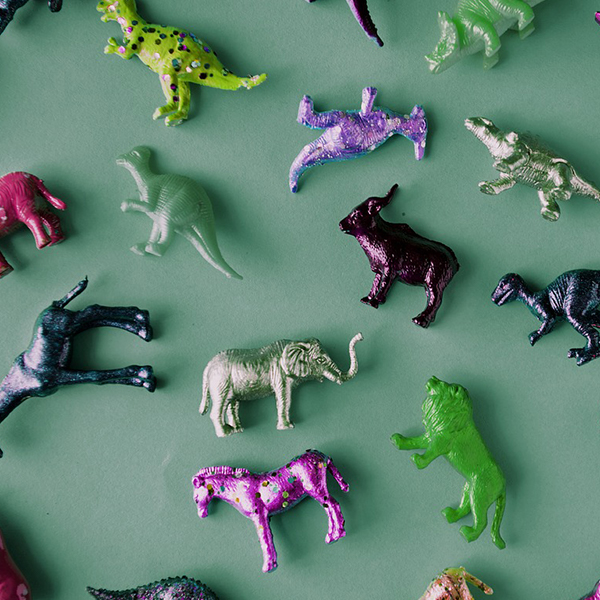
Collection of toy animals including dinosaurs (rawpixel, Pixabay)
Students will use observing and sorting & classifying skills to learn that dinosaurs are extinct animals that share common characteristics.
Overview
Students will sort and classify toys, some of which are dinosaurs and some of which are not. Through sorting and classifying, students will learn about dinosaurs as a class of extinct animals that share common characteristics.
Timing
30-45 minutes
Setting the Stage
Dinosaurs are a tremendously popular subject with many children. Dinosaurs show up everywhere in popular culture, from cartoon characters and t-shirt decorations to movie villains and sports team mascots. In fact, dinosaurs appear so vivid in popular media that it can be easy to lose sight of the fact that they’re extinct animals!
Did you know?
The word Dinosaur comes from the Greek word for “Terrible Lizard.” It was first defined by the British scientist Sir Richard Owen in 1842. Over 1 000 different types of dinosaurs have been discovered since then!
We can see many animals at the zoo. But to see a dinosaur, we have to go to museums and see their fossils. The key to getting children thinking of dinosaurs in a scientific way is to get them thinking of dinosaurs as animals that once did all of the things that animals do today.
Misconception Alert
People tend to think of any extinct creature that lived during the Mesozoic Era as a “dinosaur.” But the world in which dinosaurs lived for approximately 150 million years had many different types of animals, only some of which were dinosaurs.
Dinosaurs are a distinct class of animals. They are on the same level as amphibians, birds, fish, mammals and reptiles.
Kingdom: Animalia
Phylum: Chordata (animals with a central nervous system)
Subphylum: Vertebrata (animals with a backbone)
Class: Dinosauria
All dinosaurs share a number of common characteristics that, together, make them unique from other animals.
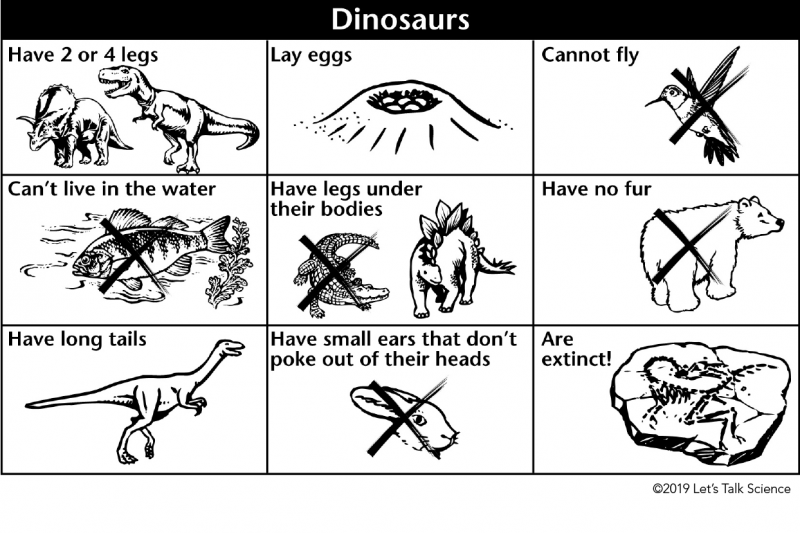
Graphic - Text Version
Dinosaurs had two or four legs, laid eggs, could not fly, could not live in water, had their bodies under their legs, did not have fur, had long tails and had small eggs. Dinosaurs are extinct.
Misconception Alert
Dinosaurs are not reptiles! Although their name translates as “Terrible Lizards,” dinosaurs are a separate class from reptiles. There are significant differences between the two classes.
In this inquiry, students will sort and class dinosaurs to learn about them as a class of extinct animals that share common characteristics.
This inquiry could begin from:
- Observing a toy dinosaur. Discuss using questions such as:
- What type of dinosaur is this?
- What body parts do dinosaurs have?
- How do we know how big dinosaurs were?

- Reading a book such as How does a Dinosaur Say Goodnight?, Boy, Were we Wrong about Dinosaurs! or I Am Not a Dinosaur. Discuss using questions such as:
- Why was the dinosaur acting this way at bedtime? How are you like this dinosaur at bedtime? (For How Does a Dinosaur Say Goodnight?)
- How have we learned more about dinosaurs? Do you think there is still more to find out?
- What kinds of dinosaurs does the little pterosaur come across? (For I Am Not a Dinosaur)

- Visiting a museum and viewing fossils at a museum, or discussing fossils students have previously seen at museums. Discuss using questions such as:
- What surprised you about the fossils?
- How did the museum display the dinosaur fossils?
- Which dinosaur is your favorite? Why?

Details
- Images of different types of dinosaurs (optional) (e.g., Diplodocus, Stegosaurus, Triceratops and Tyrannosaurus)
- Toy dinosaurs, assorted
- Toy non-dinosaurs (animals that are not dinosaurs)
- Dinosaur Classification Chart reproducible [Google doc] and [PDF]
- Sticky notes
- Sorting bins, hoops or mats
- Bag
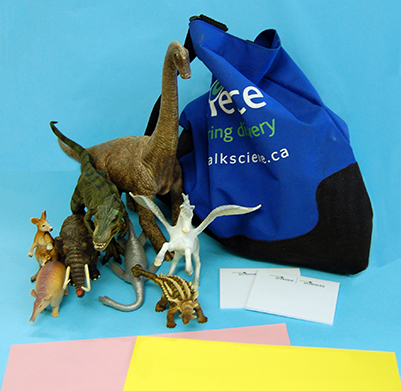
- Gather images of Diplodocus, Stegosaurus, Triceratops and Tyrannosaurus.
- Bring in toy dinosaurs and other animals and place them in the bag. If you are unable to find suitable plastic dinosaurs and other animals for the investigation, use appropriate pictures.
- Place sticky notes over the boxes on the Dinosaur Classification Chart. Familiarize yourself with the characteristics on the chart. You may wish to create your own blank chart with the children to fill in during the investigation.
- Set up bins, hoops or mats for sorting.
Students use a Sorting Mat learning strategy to develop and apply the skills of Observing, Comparing & Contrasting, Sorting & Classifying and Making Connections to learn about dinosaurs and what it means to be extinct.
- Have students observe the four dinosaur pictures. Talk about the animals in the pictures. Emphasize their similarities and differences.
- Talk about the common characteristics of dinosaurs. Remove the sticky notes to uncover the characteristics listed on the dinosaur classification chart as they are discussed. Make sure that the entire chart gets uncovered and all of the characteristics are discussed. Alternately, create a chart showing the common characteristics of dinosaurs as the characteristics are discussed.
- Using the chart, sort the toy animals into “dinosaurs” and “dino-nots” piles using a Sorting Mats learning strategy (e.g., using sorting bins, hoops or mats). As the animals are sorted, students give reasons for where they are placed.
Observe and document, using anecdotal comments, photos and/or video recordings, students’ ability to:
- Observe - students observe a variety of dinosaurs and non-dinosaurs
- Compare & Contrast - students identify similarities and differences between dinosaurs and non-dinosaurs, drawing on observations and new and prior knowledge
- Sort & Classify - students sort and classify dinosaurs and non-dinosaurs based upon given dinosaur classification criteria
- Make Connections - students use prior knowledge and information gathered to draw conclusions about the characteristics of dinosaurs and characteristics of non-dinosaurs to understand what it means to be extinct
| Students: Saying, Doing, Representing |
Educator: Responding, Challenging |
|---|---|
|
Students observe and compare and contrast a variety of types of toy dinosaurs and toy non-dinosaurs. Students discuss and explain the rules for the classification of dinosaurs, referring to the Characteristics of Dinosaurs chart. |
|
|
Students sort and classify the assortment of toys into ‘dinosaurs’ and ‘dino-nots’ groups. Students organize their sort with the aid of a graphic organizer. |
|
| Students make connections to draw conclusions about the characteristics of dinosaurs and non-dinosaurs, and what it means to be extinct . |
|
Literacy
- Use oral language to explore and develop an understanding of ideas and concepts (e.g., the difference between living animals and extinct animals)
- Use processing skills (e.g., draw conclusions about criteria for classifying dinosaurs)
Mathematical Thinking
- Organize objects into categories by sorting and classifying objects (e.g., sort and classify dinosaurs from non-dinosaurs; sort and classify using specific criteria)
- Counting (e.g., number of dinosaurs and non-dinosaurs, number of two-legged versus four-legged dinosaurs)
- Ordering (e.g., by size, from smallest to largest)
- Add other types of animals (both dinosaurs and non-dinosaurs) to the sort pile.
- Sort by only some of the characteristics (e.g., have long tails, have legs under their bodies) instead of the entire array. What other types of animals get sorted together with dinosaurs when this is done?
- Brainstorm a list of dinosaurs.
Did you know?
Scientists now classify birds as living dinosaurs. They are part of the family known as theropods. This is the same family that all carnivorous dinosaurs belonged to! Why?
- Fossils show that some dinosaurs had feathers
- Birds and meat-eating dinosaurs have similar skeletons
If you have trouble thinking of a bird as a dinosaur, take a really good look at a bird’s leg and foot.The next time you see a bird, imagine it as a distant cousin of Tyrannosaurus!


How Do Dinosaurs Say Goodnight?
By Jane Yolen
A playful peek into the homes of dinosaur children and their parents at bedtime.
ISBN: 9780007137282
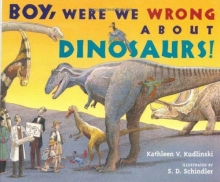
Boy, Were We Wrong About Dinosaurs!
By Kathleen V. Kudlinski
Examines what is known about dinosaur bones, behavior, and other characteristics and how different the facts often are from what scientists, from ancient China to the recent past, believed to be true.
ISBN: 978-0142411933
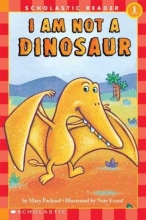
By Mary Packard
As a baby pterosaur learns how to fly, it gains self-esteem and discovers the many dinosaurs in its Jurassic landscape.
ISBN: 9780590689977
Reproducible
Dinosaur Classification Chart [Google doc] [PDF]
How did dinosaurs leave fossils behind? (Hands-on Activities)
Using a toy dinosaur and some plaster of Paris, learn how dinosaur footprints could become fossils.
The Classification of Life: From Linnaean Taxonomy to DNA Barcoding (Backgrounder)
Learn about the ways that we've learned to classify the life around us.
Jordan Mallon - Research Scientist in Palaeobiology (Careers)
Career profile of a Research Scientist in Palaeobiology.
Materials
- Images of different types of dinosaurs (optional) (e.g., Diplodocus, Stegosaurus, Triceratops and Tyrannosaurus)
- Toy dinosaurs, assorted
- Toy non-dinosaurs (animals that are not dinosaurs)
- Dinosaur Classification Chart reproducible [Google doc] and [PDF]
- Sticky notes
- Sorting bins, hoops or mats
- Bag

Preparation
- Gather images of Diplodocus, Stegosaurus, Triceratops and Tyrannosaurus.
- Bring in toy dinosaurs and other animals and place them in the bag. If you are unable to find suitable plastic dinosaurs and other animals for the investigation, use appropriate pictures.
- Place sticky notes over the boxes on the Dinosaur Classification Chart. Familiarize yourself with the characteristics on the chart. You may wish to create your own blank chart with the children to fill in during the investigation.
- Set up bins, hoops or mats for sorting.
What to Do
Students use a Sorting Mat learning strategy to develop and apply the skills of Observing, Comparing & Contrasting, Sorting & Classifying and Making Connections to learn about dinosaurs and what it means to be extinct.
- Have students observe the four dinosaur pictures. Talk about the animals in the pictures. Emphasize their similarities and differences.
- Talk about the common characteristics of dinosaurs. Remove the sticky notes to uncover the characteristics listed on the dinosaur classification chart as they are discussed. Make sure that the entire chart gets uncovered and all of the characteristics are discussed. Alternately, create a chart showing the common characteristics of dinosaurs as the characteristics are discussed.
- Using the chart, sort the toy animals into “dinosaurs” and “dino-nots” piles using a Sorting Mats learning strategy (e.g., using sorting bins, hoops or mats). As the animals are sorted, students give reasons for where they are placed.
Assessment
Observe and document, using anecdotal comments, photos and/or video recordings, students’ ability to:
- Observe - students observe a variety of dinosaurs and non-dinosaurs
- Compare & Contrast - students identify similarities and differences between dinosaurs and non-dinosaurs, drawing on observations and new and prior knowledge
- Sort & Classify - students sort and classify dinosaurs and non-dinosaurs based upon given dinosaur classification criteria
- Make Connections - students use prior knowledge and information gathered to draw conclusions about the characteristics of dinosaurs and characteristics of non-dinosaurs to understand what it means to be extinct
Co-constructing Learning
| Students: Saying, Doing, Representing |
Educator: Responding, Challenging |
|---|---|
|
Students observe and compare and contrast a variety of types of toy dinosaurs and toy non-dinosaurs. Students discuss and explain the rules for the classification of dinosaurs, referring to the Characteristics of Dinosaurs chart. |
|
|
Students sort and classify the assortment of toys into ‘dinosaurs’ and ‘dino-nots’ groups. Students organize their sort with the aid of a graphic organizer. |
|
| Students make connections to draw conclusions about the characteristics of dinosaurs and non-dinosaurs, and what it means to be extinct . |
|
Cross-curricular Connections
Literacy
- Use oral language to explore and develop an understanding of ideas and concepts (e.g., the difference between living animals and extinct animals)
- Use processing skills (e.g., draw conclusions about criteria for classifying dinosaurs)
Mathematical Thinking
- Organize objects into categories by sorting and classifying objects (e.g., sort and classify dinosaurs from non-dinosaurs; sort and classify using specific criteria)
- Counting (e.g., number of dinosaurs and non-dinosaurs, number of two-legged versus four-legged dinosaurs)
- Ordering (e.g., by size, from smallest to largest)
Extending the Learning
- Add other types of animals (both dinosaurs and non-dinosaurs) to the sort pile.
- Sort by only some of the characteristics (e.g., have long tails, have legs under their bodies) instead of the entire array. What other types of animals get sorted together with dinosaurs when this is done?
- Brainstorm a list of dinosaurs.
Did you know?
Scientists now classify birds as living dinosaurs. They are part of the family known as theropods. This is the same family that all carnivorous dinosaurs belonged to! Why?
- Fossils show that some dinosaurs had feathers
- Birds and meat-eating dinosaurs have similar skeletons
If you have trouble thinking of a bird as a dinosaur, take a really good look at a bird’s leg and foot.The next time you see a bird, imagine it as a distant cousin of Tyrannosaurus!

Supporting Media

How Do Dinosaurs Say Goodnight?
By Jane Yolen
A playful peek into the homes of dinosaur children and their parents at bedtime.
ISBN: 9780007137282

Boy, Were We Wrong About Dinosaurs!
By Kathleen V. Kudlinski
Examines what is known about dinosaur bones, behavior, and other characteristics and how different the facts often are from what scientists, from ancient China to the recent past, believed to be true.
ISBN: 978-0142411933

By Mary Packard
As a baby pterosaur learns how to fly, it gains self-esteem and discovers the many dinosaurs in its Jurassic landscape.
ISBN: 9780590689977
Reproducible
Dinosaur Classification Chart [Google doc] [PDF]
Learn More
How did dinosaurs leave fossils behind? (Hands-on Activities)
Using a toy dinosaur and some plaster of Paris, learn how dinosaur footprints could become fossils.
The Classification of Life: From Linnaean Taxonomy to DNA Barcoding (Backgrounder)
Learn about the ways that we've learned to classify the life around us.
Jordan Mallon - Research Scientist in Palaeobiology (Careers)
Career profile of a Research Scientist in Palaeobiology.